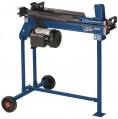Splitting force
The greatest force that the wood splitter is able to apply to the workpiece in the process of splitting.
This parameter is relevant for hydraulic and rack units (see "Type"). Even in the simplest such devices, the splitting force reaches several tons. In general, high force allows you to cope with hard and thick workpieces, however, it requires high power and strength, which significantly affects the price and weight of the entire unit. Therefore, it is worth choosing a model according to this characteristic, taking into account the specifics of the work.
So, for use in the private sector, a wood splitter with a splitting force of up
to 5 tons is considered quite sufficient, for boiler rooms and other relatively large consumers —
5-8 tons (up to 10 tons), and
more powerful devices are intended mainly for industrial use.
Max. log length
The longest log that a log splitter can handle. In fact, this is the largest distance that the stop and working nozzle can be spread; if the workpiece is longer than this distance, it will have to be sawn.
Note that this indicator significantly affects the dimensions (especially in a horizontal working position), and the force required to split a long log is quite high. Therefore, for small volumes of work (for example, when harvesting firewood for a private house), a wood splitter with a relatively small maximum length is often the best choice —
up to 60 cm ; longer workpieces can be sawn. But models of
more than 60 cm are intended mainly for work on a large scale.
Oil volume (hydraulic system)
The total amount of oil that can fit into the hydraulic system of the respective log splitter (see "Type"). This parameter allows you to estimate how much oil is required for one refueling or refilling of the unit.

